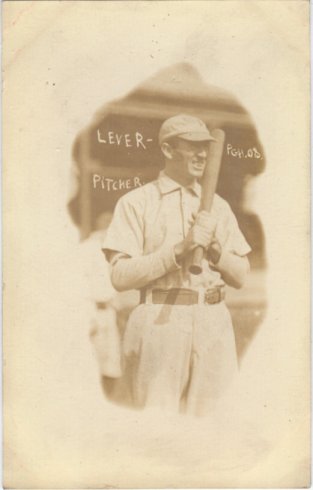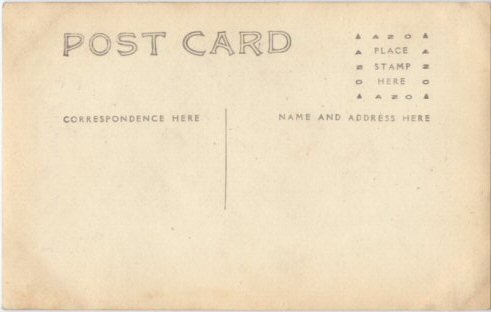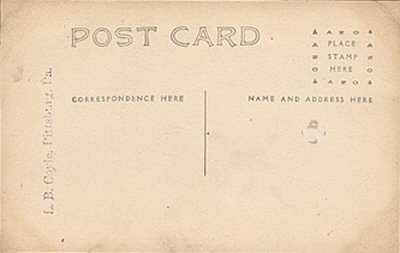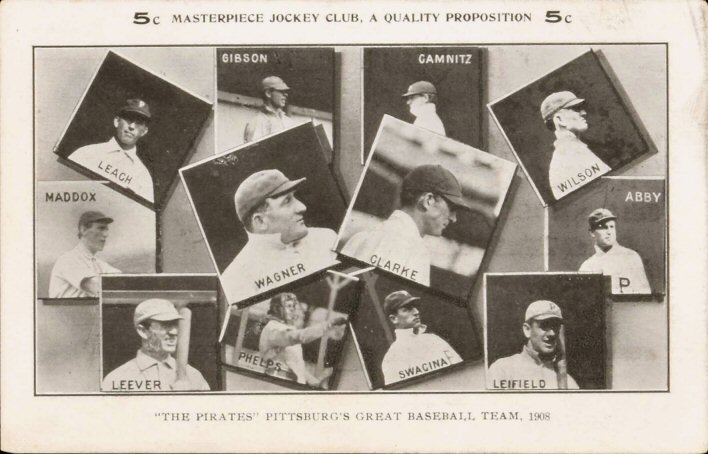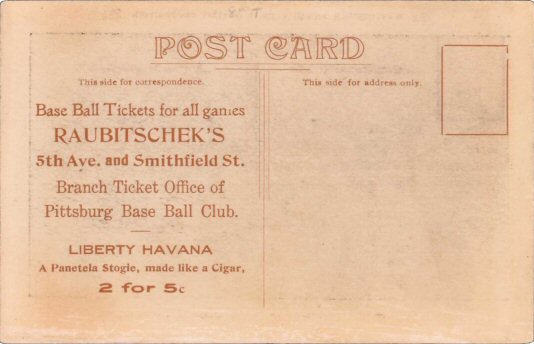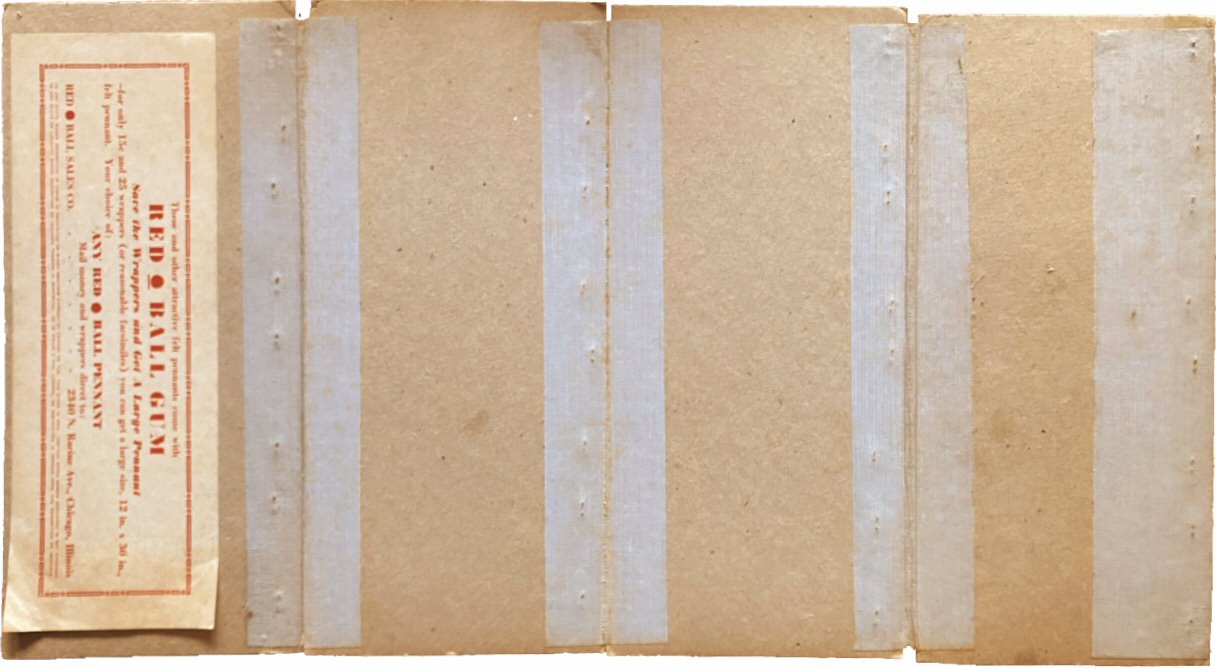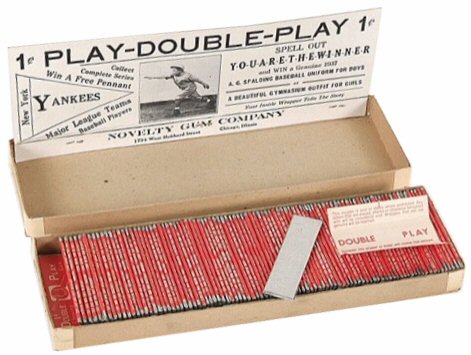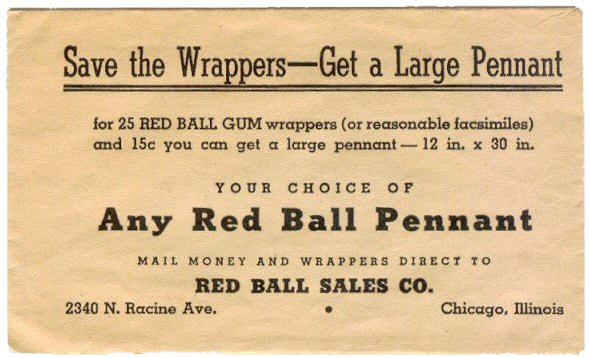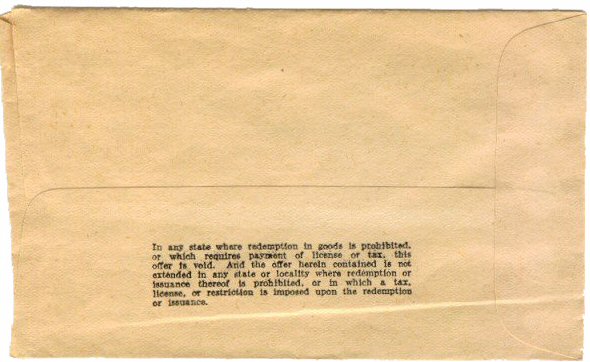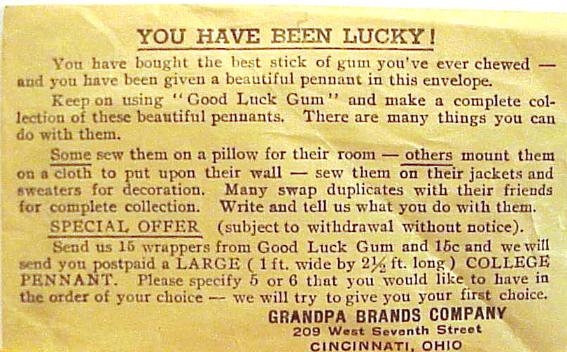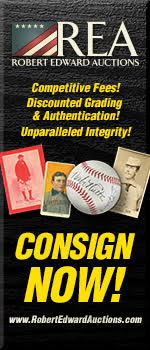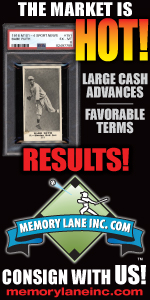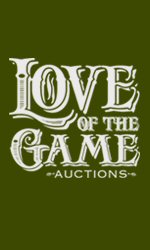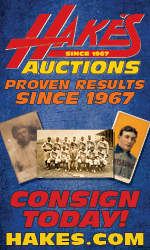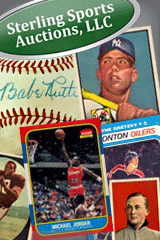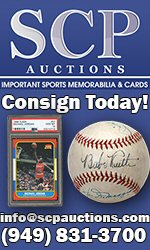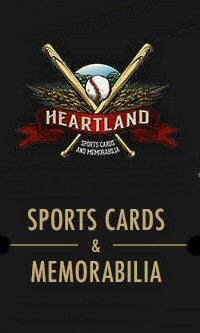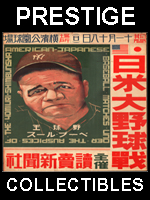
Your Information Resource for Vintage Baseball Cards
Old Cardboard eMagazine Issue #177 March 2021
|
Welcome to Old Cardboard, the most complete reference resource for information about collecting vintage baseball cards and related memorabilia. More information about this eMagazine and its companion website is found at the bottom of this page.
Contents:
1. Updated Auction and Show Calendar
The following is a summary of vintage card events coming up in the next 90 days. For the most current listings of additional vintage card shows and auctions, see the Key Events Calendar, accessible directly from the home page of the Old Cardboard website.
Have an event that needs to be on the OC Calendar?
2. Set Profile: 1908 PC800 Pirates Vignettes Postcards
The set contains 14 known sepia-toned cards, which could be stored in an album that was also available. Of these, cards for about half of the players have been discovered in the early decades of the twentieth century, a testament to the set's rarity. The issue is believed to contain 15 cards, so there is one card yet to be discovered.
The player's last name is hand lettered in white over a dark background on each card. The player's position is also provided. A "PGH '08" is also found printed on the cards, indicating that the set is for the Pittsburgh team in 1908. The Pirates won the World Series the following year.
The 3-1/2 by 5-1/2 inch cards are printed with postcard indices on the backs.
As might be expected, the Honus Wagner card is the key card in the set. In fact, as the result of a 2017 discovery and sale in an REA auction, there are now two Wagner cards. One shows Honus sitting on the ground in a relaxed position. The other (2017 discovery) shows him in a batting stance. Both cards are displayed in the PC800 Set Gallery on the Old Cardboard website.
A hand stamp for what appears to be the printer of the cards are the words "L. B. Coyle, Pittsburgh, Pa." is stamped on a few (less than 10-20 percent) of the known cards.
Although it is generally accepted among collectors that "Coyle" was the one that produced the set, it is possible that this is the stamp of an early collector that owned the cards.
Examples from the set were apparently not available to Jefferson Burdick, editor of the American Card Catalog. As a result, the set is not listed in the final (1960) edition of the ACC. However, the set is identified with hobby number PC800 a couple of decades later in the Sports Collectors Bible.
It has been reported (although we have not been able to confirm) that an album was also produced to contain the postcards. The album would confirm (as has also been reported) that there are fifteen cards in the set. Any feedback from our readers with knowledge of the album would be much appreciated.
Interestingly, another 1908 postcard featuring the Pirates (not part of this set) was produced as a composite of "head-only" images of twelve players (see example below).
Note that the only player in the "Composite" postcard that is not represented in the PC800 set is Pitcher Lefty Leifield. Similarly, there are two players from the PC800 series (Dan Moeller and Alan Stroke) that are not represented in the "Composit" postcard.
A Set Profile, Checklist and Gallery of all known cards in the PC800 series have been added to the Old Cardboard website.
[Editor's Note: Over the past decade or two, vintage collectors have slowly gained knowledge about the 1936-38 BF3 Felt Mini-Pennants. New patterns have emerged which have resulted in the need for small but significant revisions in the classifications for several subsets, or "Types," of BF3s. The various subsets were last checklsted in the 2008 edition of the Standard Catalog of Baseball Cards. Although editors of the final 2015 edition of the Standard Catalog, working with Jim Sexton, author of the article below, agreed that the revisions were needed, the revisions did not get implemented. Rather, the checklists for each BF3 Type were removed and replaced by a short and general statement about the overall set. In the blockbuster article that follows, author Jim Sexton has painstakingly explained these revisions and the reasons they were made.]
* * *
Not counting color variations, the series identified in the American Card Catalog (ACC) as BF3 contains several hundred felt mini-pennants. With color variations, this number quickly climbs into the thousands.
Given this large number of pennants and the complexity of their styles, it is not surprising that there exists some confusion about what actually constitutes a BF3 pennant. There is general agreement among collectors today that the two defining characteristics of BF3s are their size and date of origin. The ACC describes a BF3 as being four and one half inches in length. Actually BF3s vary slightly in size, measuring between four and one quarter and four and one half inches.
The other defining characteristic of BF3s (i.e., their 1936-1938 date of issue) will be discussed later in this article.
Size and date are about all these little pennants have in common. Early collectors tried to bring order into this diversity by grouping BF3s, based on common designs and style, into eleven (now extended to twelve) different "Types." But many new discoveries have resulted in the need for moderate revisions to previous classifications. These revisions have been addressed and implemented in this article. Further, comprehensive checklists and galleries for each BF3 Type have been added to the Old Cardboard website and are linked as needed from the narrative below.
The Twelve BF3 Types
The first three groups or "Types" of BF3s are player pennants (i.e., they all have the names of individual players printed on them. All three of these types are based on identical checklists of the same sixty-one players. Each type, however, features a different design. Several pennants from Type 1 and Type 2 have yet to be discovered, as indicated in the checklists on the Old Cardboard website.
The silhouettes, which are found on both Type 1 and Type 2 pennants, are printed in a variety of action poses (i.e., running, throwing, batting, etc.).
Type 1 pennants are less common than those in Type 2 or Type 3. Of the sixty-one players, pennants for Medwick, Simmons and Terry have not been confirmed to exist by today's collectors.
Most of the pennants in the first three groups are printed in heavy block letters. But for some unknown reason, several pennants from groups two and three are found in a thin script type style. Another interesting note is the staying power of Babe Ruth who is found in all three groups even though he was no longer an active player after 1935.
In the updated checklists and galleries provided on the Old Cardboard website, a new Type 4 has been inserted that contains a well defined group produced by the Red Ball Sales Co. of Chicago (discussed in more detail below). This is a group of sixteen team pennants, previously found in Types four, five and eight, that deserve recognition as a unique set.
With a total of thirty-two pennants (two pennants for each of the eight Major League teams), it is presumed that the checklist is complete. Because these pennants are found in a multiplicity of printing font styles, more than one manufacturer is probable. Mini pennants for the "Cards" and the "Sox" appear to be anomalies among BF3 types but are included with Type 6 as they seem to match closely with the simple Type 6a design.
Curiously, the American Card Catalog has a listing for a pennant very similar to this called a BF4. Burdick's description for the BF4s in the ACC reads, "Baseball Players Names, C. 1935 about 6 in,. with gum or candy" with an estimated value in 1960 of 8 cents. Most longtime BF3 collectors contend that the "lost" BF4s are non-other than the type seven BF3s. These pennants, because of their size, are much closer to Burdick's description of a BF4 and should no longer be considered BF3s. There are currently 26 pennants identified in this group. They are now appropriately listed on the Old Cardboard website as BF4 Felt Mini Pennants. The new Type 7 BF3 is a group of previously unknown and uncataloged BF3s. These pennants are exceedingly rare, the majority of which have only recently been identified. In the design of this pennant a player's name is printed in the center with a team name reversing out of a bat which stands vertically in the spine. There are a total of sixteen known pennants in this group.
In this design, a bat is found in the center of the pennant. A team name is reversed out of the bat with the name of a player printed above and below the bat. There are nineteen known examples in this group. Type 7 and Type 8 checklists are almost certainly incomplete and although extremely rare, additional examples will probably show up in the future.
Two larger pennants closely related to Type 9s are also known and are designated here as Type 9b. These pennants are somewhat larger (8-1/2 inches in length) and have the same baseball design as their smaller counterparts. Aside from their difference in size, the premiums also have a wide vertical white bar printed along the spine. Only two examples have been found in the larger premium format: those for Charley Grimm and Jimmie Dykes, managers of the Cubs and White Sox, respectively. One can only speculate whether these were store displays, premiums, or the product of some other promotion. Both of the known Type 9b pennants (Grimm and Dykes) are displayed in the Type 9 Gallery on the Old Cardboard website.
The 1938 Tigers pennants are now designated as Type 10a because of another exciting find. A 1938 "Blues" pennant in the same style as the Tigers has been discovered at a Kansas City estate sale. It is the only known minor league BF3 player pennant, and has been cataloged as a Type 10b. The player named on the pennant is Bob Miller, a pitcher for the 1938 Kansas City Blues of the American Association.
There are a total of twenty-four pennants in the set that depict all eight teams from each of the three leagues. Each pennant is printed with a team nickname and an accompanying graphic related to baseball or the team. There is also an abbreviated league name found on all Type 11 pennants.
Type twelve BF3s form a very large category of relatively common cards, all focused on colleges and universities in the United States. Although some display graphics for football, most are "sport-neutral" and display only the name of the college. The BF3 College pennants are included in the American Card Catalog description for BF3s and are among the most abundant of all BF3s. They generally make up about half of the BF3s listed on eBay at any point in time. Well over 100 colleges are represented in the Type 12 subset. Note: at least one BF3 reference has (somewhat erroneously) designated a group of Red Ball Gum premium pennants as BF3 Type 12. These premiums are enlarged versions of the sixteen Red Ball Gum "regular" mini pennants now designated as BF3 Type 4a. As such, the premium pennants are now designated as BF3 Type 4b (Red Ball Jumbos). Of the above twelve BF3 types, Types seven, eight and ten are a real mystery, largely because so few of them have been found. Could these have been prototypes or salesmen's samples meant for distribution in 1938, but because of the premature failure of the company were never produced in quantity? Availability It is not an understatement to say that BF3s are quite limited in availability. Despite the huge number of different BF3s, many are extremely difficult to find. Even the most advanced and longtime collectors have never seen some of the pennants after decades of collecting. This scarcity obviously has reduced their popularity. Set collectors of BF3s are almost non-existent. Groups of these pennants do show up on rare occasions in auctions or at shows, but the primary source of BF3s in recent years has been eBay. The team pennants are generally more common and less expensive than the player pennants. Types seven, eight and ten BF3s are hardly ever seen and must be considered rare. Since few collectors are knowledgeable about BF3s, cost is not necessarily related to rarity, but rather to player popularity or to reasons known only to the individual collector. As a result, cost is almost impossible to predict. A common team pennant may sell for as little as ten dollars while a Ruth player pennant may sell for several hundred dollars or more. Dating and Speculation on Origin The evidence pertaining to the origin of BF3s is sketchy and incomplete. Dating the majority of these little pennants, however, has not been the problem. Since many BF3s have both player and team name on the same pennant, it has been a simple step to check player registers and come up with the actual date. In addition types nine and ten have a date printed on them. There seems to be little doubt that the years of distribution were between late 1936 and early 1938. The only possible exceptions might be some of the team pennants which cannot be dated accurately. There is a significant amount of evidence establishing the Red Ball Sales Company, which was located in Chicago, as a primary source of BF3 pennants. The name of this company first appears in the official directory of Illinois corporations for 1937. Its name appeared for a second and last time in the directory the following year. Additional information about the company's inception was found in the 1937 Chicago Daily Tribune. In the Fall of that year, over a period of several weeks, classified ads were placed in the Tribune by the Red Ball Sales Company. The text stated that Red Ball, a national gum company, was looking to hire as many as nine salesmen to sell both in the Chicago area as well as in a national market. It can be inferred from these ads that Red Ball was probably a new company in the process of expansion. Red Ball was first listed in the Chicago telephone directory in 1937, but does not appear in the 1938 or in any subsequent directory. It is quite probable that the company existed only from late 1936 or early 1937, to possibly early 1938. One can speculate that the short but severe depression that occurred in 1937 may have been the cause of its demise. Note that the dating of the company coincides with the dating of the BF3 pennants.
The Red Ball Sales Co., even though short lived, did leave behind a trail of evidence linking it with the BF3 pennants. The above four-panel display surfaced in a March, 2000 auction. The 11 by 20-inch, hard cardboard store display, with sixteen BF3 team pennants affixed to the front was likely used as a salesman's sample for the mini-pennants. On the back of the display is a sticker identifying Red Ball Sales as the distributor. The sticker states that "these and other attractive felt pennants come with Red Ball gum". The sticker also mentions a premium offer: "for only 15c and 25 Red Ball gum wrappers...you can get a large size, 12 in. by 30 in., felt pennant." Although quite rare, these large premiums are known to collectors today and are identified as BF3 Type 4b (Jumbo Pennants) on the Old Cardboard website. Note that the sixteen team pennants found on the store display are by far the most common of all BF3s. Previously found in types four, five and eight, these pennants more correctly should be listed as a separate set. So after merging the previous Type 4 with Type 5, the Red Ball set has now become the new BF3 Type 4.
A 2009 discovery of unopened boxes of candy and gum, dating to the 1930s has brought to light another Red Ball Sales product. Included in the find was an almost complete box of 100 sticks of Red Ball gum. Also in the box were approximately 25 BF3 pennants each in its own small envelope. A small store display also came with the box explaining how to win a pennant. Despite the fact that these were "college" rather than baseball pennants, the Red Ball box does give us a clue to how some BF3s were distributed.
On the inside of the gum wrapper (on 80 of the 100 sticks) were printed different letters. If one collected the letters that spelled out Y-O-U-A-R-E-A-W-I-N-N-E-R, and then mailed the wrappers to the Novelty Gum Company, he or she would receive a 1937 Spalding baseball uniform for boys or a beautiful gymnastic outfit for girls. The poster went on to explain that a wrapper without a letter could be exchanged at the local retailer for a small baseball pennant. It states, "Win a free pennant. Collect a complete series of all major league teams and baseball players." The only known groupings of small baseball pennants from this period are the BF3 pennants. From this information it seems quite probable that the Novelty Gum Company was another distributor of one or more BF3 types.
Four or five different versions of wrappers used to distribute the BF3 pennants have been encountered by collectors. Most are blank, but some are imprinted with the same information found on the store display produced by the Red Ball Sales Co., giving us additional evidence linking that company with BF3 distribution.
Glassine envelopes containing Type 6 BF3s were also distributed by the Cunningham Ice Cream Company, a division of the Borden Co. Anecdotes from multiple sources indicate that (at least some of) the pennants were distributed at the point-of-sale with the purchase of gum. Typically, the source was a child or grandchild of the original collector who stated that "he picked them out at a store when he bought candy." In all the above investigations and findings, the 1937 date keeps reappearing and no other date of origin has come to the surface. That all these companies should have distributed these pennants during this same time period, seems to be more than a coincidence. Was there a large manufacturer who sold the BF3s to other companies to use in their promotions and then shortly disappeared? The small amount of information that has been uncovered about these little pennants is dwarfed by many unanswered questions. Hopefully as more resources are examined, additional information about their origin and history will come to light. In the meantime BF3 mini pennants will remain a unique collectible from a golden age of baseball. The BF3 Profile Page on the Old Cardboard website has been updated to reflect the above additions and changes. Any additional information or comments would be appreciated. The author can be reached at jim_sexton@hotmail.com.
We are continually expanding the Old Cardboard website with more set profiles, checklists and card galleries. Recent (past 30-40 days) additions include:
Set Profiles have been added for:
Set Checklists have been added for:
Set Galleries have been added for: Updating the website with checklists and full set galleries for additional vintage sets is an ongoing project, so check back often to check out the latest additions. There are now many thousands of card images on the website and the list continues to grow every month. We welcome and encourage feedback with checklist additions, images of cards missing from our galleries, error corrections and suggestions. Please send all feedback to editor@oldcardboard.com.
Beyond the above pages recently added to the Old Cardboard website, we continue to expand and refine our eBay Custom Search Links to make finding vintage baseball cards on eBay easier than ever. The results of these searches are continuously changing, so check back often to find the most recent eBay listings. Samples of a few of these custom searches are provided below. Hundreds more are provided on the Set Profile pages throughout the Old Cardboard website.
5. News Briefs (A Digest of Recent Hobby Happenings)
Jerry Hurley added to Bregstone Postcard checklist.
A postcard for catcher Jerry Hurley has been identified and added to 1908-11 PC743 H. H. Bregstone Postcards checklist. Thanks to Old Cardboard reader Mike Garrity, we have been able to add Hurley to the Checklist and Gallery for the Bregstone set. Hurley is pictured and identified on the card as a catcher for the Cardinals. Unfortunately, Hurley retired from Major League Baseball in 1907 and is not found on the Cardinals roster during the years that the Bregstone set was produced. The Bregstone checklist now contains 38 players.
Old Cardboard LLC. was established in December 2003 to help bring information on vintage baseball card collecting to the hobbyist. Produced by collectors for collectors, this comprehensive resource consists of three components: (1) Old Cardboard Magazine (currently on hold after printing 34 Issues), (2) a companion website at www.oldcardboard.com and (3) this eMagazine. The Old Cardboard website contains well over 1000 pages of descriptive reference information for baseball card sets produced fifty years ago or longer. Each of the set summaries has a direct set-specific link to |
| |||||||||||||||||||||||||||||||||||||||||||||||||||||||||||||||||||||||||||||||||||||||||||||||||||||||||||||||||||||||||||
